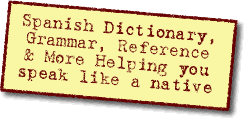Ask a Question(Create a thread) |
|
|||||||
The consonants S and TTeaching methodology, learning techniques, linguistics-- any of the various aspect of learning or teaching a foreign language. |
 |
|
|
Thread Tools | Display Modes |
|
#1
|
|||
|
|||
|
The consonants S and T
In English the tongue is basically in the same position for making both S and T. Knowing the T in Spanish is made with the tongue touching the upper front teeth, it seems to require a mighty quick jump to achieve the combination S-T. Does that very challenge explain the tendency of some to pronounce esta as either e'tah or eth-tah? In saying that word, and others like it, I have been known to cheat on the T portion, by keeping my tongue up toward the hard palate where it just was for the S, but I'm afraid it sounds too much like a T in English. Any suggestions?
|
|
Get rid of these ads by registering for a free Tomísimo account.
|
|
#2
|
||||
|
||||
|
You're cheating by trying to retain an English articulation of /s/, rather than pronouncing /s/ with the tongue somewhat closer to the back of the teeth to make it easier to pronounce a following /t/, as many native speakers of Spanish do.
Speakers who aspirate /s/ do so at the end of most syllables, regardless of what sound follows: the aspiration or absence of /s/ does not occur only in front of /t/. |
|
#3
|
|||
|
|||
|
Quote:
Pronouncing "esta" is not difficult for us.
__________________
Corrections always very welcome 
|
|
#4
|
|||
|
|||
|
Many thanks, wrholt. I never knew there was a distinction, that the tongue should be brought closer to the teeth in making the S sound, but it makes sense. And, makes it easier to go quickly from S to T. I owe you one for that!
|
|
#5
|
||||
|
||||
|
Quote:
Native speakers of every language automatically and unconciously adjust their pronunciations of individual speech sounds to make the transition from one sound to the next easier. However, there is no guarantee that native speakers of two different languages will use the same types of adjustments between two similar sounds. |
 |
«
Previous Thread
|
Next Thread
»
| Link to this thread | |
|
|
|||||||
All times are GMT -6. The time now is 01:56 PM.








 Linear Mode
Linear Mode

